
Going to Barcelona, one of Europe's emblematic cities, as a tourist and not visiting Park Güell is like leaving something unfinished. A kind of inner remorse that leads us to think: I was in this splendid city and I didn't go to visit Gaudí's "living soul". The place where the brilliant Catalan architect gave free rein to his creative fantasy.
Park Güell is the place where Antoni Gaudí could best express not only his creative fantasy but also his total union and harmony with nature.
For this reason, Park Güell is a combination of innovative and creative art, fun for the little ones, a cultural centre for the adults and last but not least a real natural park, with lakes and plants where you can walk around, take a ride in small boats, admire the beauty of the landscape and the city of Barcelona from the top of the hill, relax and enjoy a unique and unrepeatable spectacle.
Today I am going to refer to a place inside Park Güell that is full of history: The Hall of the Hundred Columns (which are actually 86) also technically called the Hypostyle Hall of Park Güell, which are the ones that support the entire infrastructure of the square of the park.
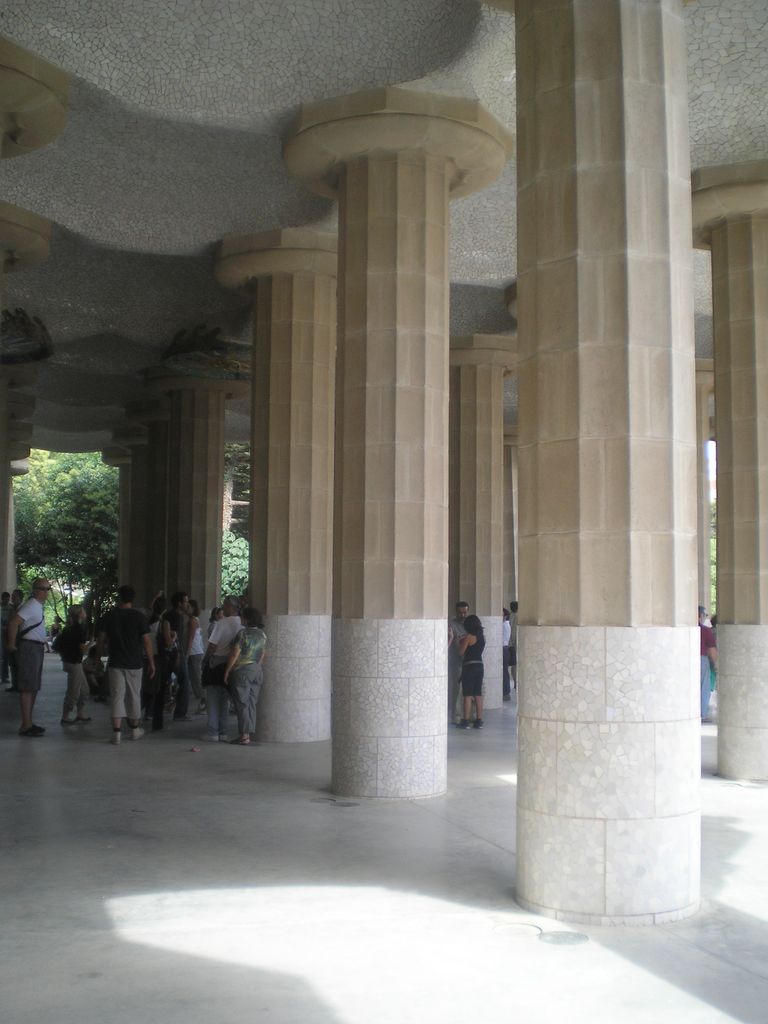
Ir a Barcelona, una de las emblemáticas ciudades europeas, como turista y no visitar Parque Güell es como dejar algo pendiente. Una especie de remordimiento interno que nos lleva a pensar: estuve en esta esplándida ciudad y no fui a visitar el "alma viva" de Gaudí. El lugar donde el genial arquitecto catalán dió rienda libre a su fantasía creativa.
Parque Güell es el lugar donde mejor Antoni Gaudí pudo expresar no solo su fantasía creativa sino su total unión y armonía con la naturaleza.
Por este motivo el Parque Güell es un conjunto de arte innovativo y creativo, diversión para los más pequeños, centro de cultura para los más grandes y por último y no menos importante un verdadero parque natural, con lagos y plantas donde se puede recorrer el mismo, hacer un paseo en pequeños botes, admirar la belleza del paisaje y de la ciudad de Barcelona desde lo alto de la colina, descansar y gozar de un espectáculo único e irrepetible.
Hoy me voy a referir a un lugar dentro del Parque Güell que está lleno de historia: La Sala de las Cien Columnas (que en realidad son 86) llamada también técnicamente la Sala Hipóstila de Parque Güell que son las que sostienen la entera infraestructura de la plaza del parque.
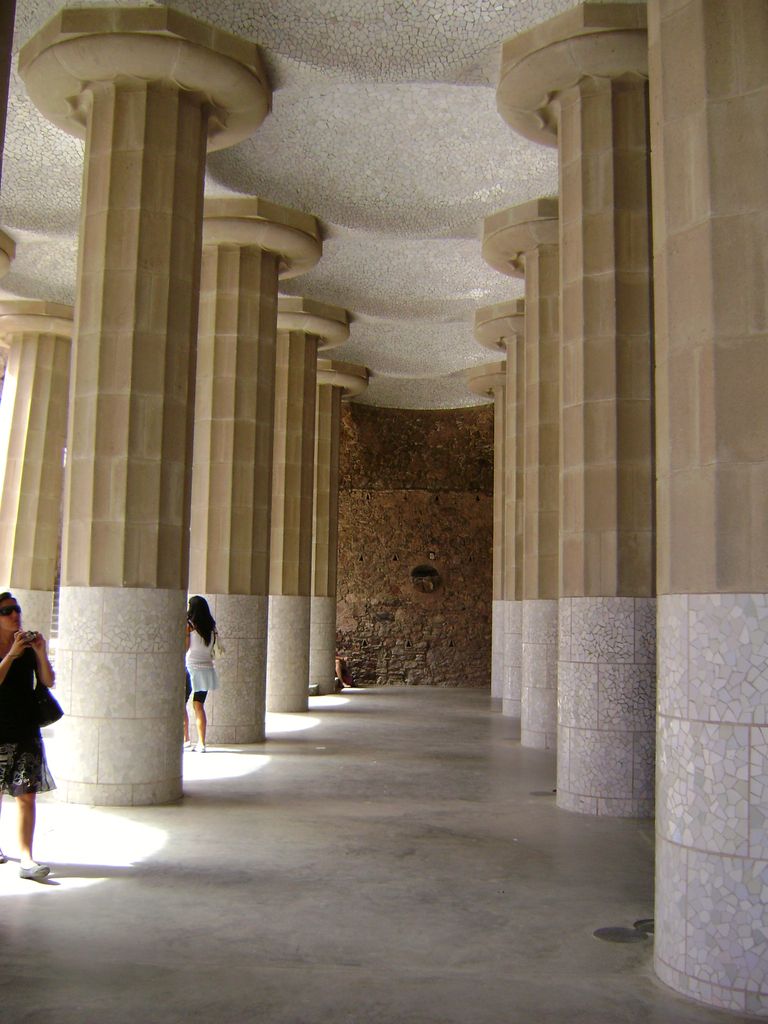
In reality Gaudí designed them not for a square but for a huge market in a residential neighbourhood that was never built.
The Doric shape of the columns is reminiscent of an ancient Greek market. This may have been the thinking of the great Catalan architect.
But as we know, Gaudí did not use plans in the best sense of the word (and in the sense that building planimetry has today), but only used hand sketches that he designed and modified as the work progressed. On the other hand, he never explained the motivations or inspirations that drove him in his projects.
Therefore, interpreting Gaudí's work is a real challenge to the author's creative fantasy.
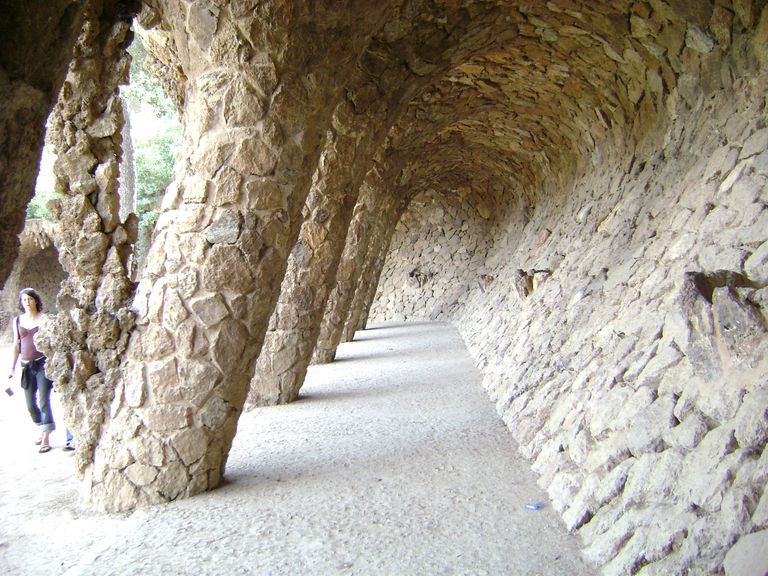
En realidad Gaudí las proyectó pensando no en una plaza sino en un enorme mercado de un barrio residencial que nunca llegó a construirse.
La forma dórica de las columnas hace pensar a un mercado de la antigua Grecia. Tal vez ese haya sido el pensamiento del gran arquitecto catalán.
Pero como se sabe Gaudí no usaba planos en el mejor sentido de la palabra (y en el sentido que tiene la planimetría edilicia en la actualidad) sino que usaba solo bosquejos a mano que iba diseñando y modificando a medida que avanzaba la obra. Por otro lado nunca explicaba las motivaciones o inspiraciones que lo impulsaban en sus proyectos.
Por lo tanto interpretar la obra de Gaudí es un verdadero desafío a la fantasía creativa del autor.
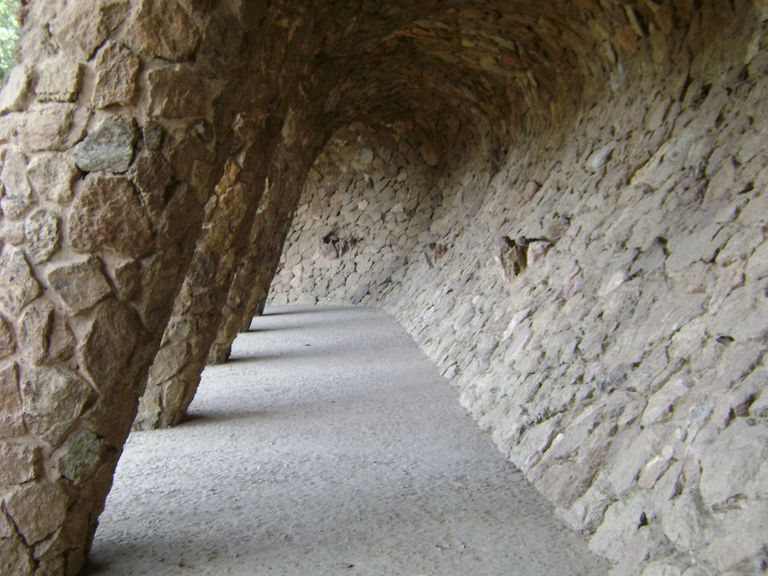
The grand entrance staircase leads immediately to the Hypostyle Hall, made up of 86 fluted columns inspired by the Doric style, the oldest of the Greek architectural styles.
Gaudí's hallmark is not so much in the type of columns as in the way some of them are totally inclined, in a style totally contrary to the rules of classical composition.
The religious significance of all Gaudí's works is evident in the absence of columns in some parts of the interior of the room, simulating the naves of a temple.
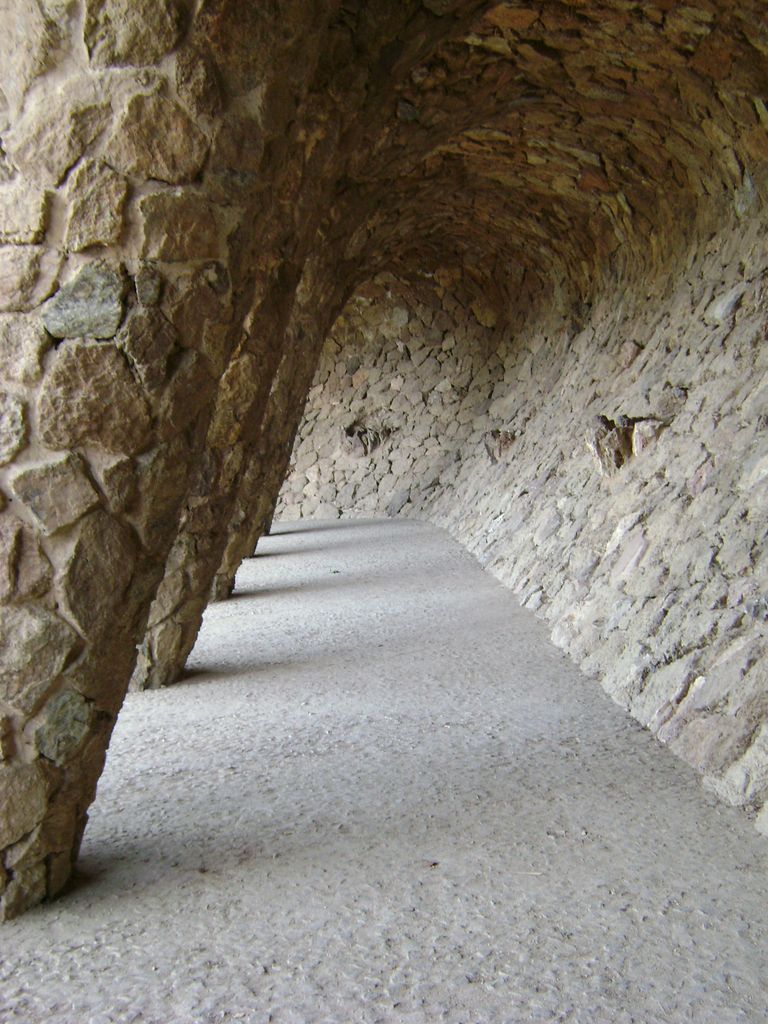
La gran escalera de acceso nos conduce de inmediato a la Sala Hipóstila formada por 86 columnas estriadas inspiradas en el estilo dórico, el más antiguo de los estilos arquitectónicos griegos.
El sello de Gaudí está no tanto en el tipo de columnas sino en la forma que tienen algunas totalmente inclinadas, en un estilo totalmente contrario a las reglas de la composición clásica.
El significado religioso que tienen todas las obras de Gaudí se manifiesta en la ausencia de columnas en algunas partes del interior de la sala, simulando las naves de un templo.

An absolutely striking feature is the pipe installed inside the hall that collects the rainwater that filters down from the square and then stores it in a large underground cistern.
The dragon on the staircase from whose mouth the water flows out is a detail where the artistic meets the practical, yet another stroke of genius in the art of the great Catalan architect.
The columns are fluted and the outermost ones lean, in a movement that at first sight seems to undulate in space.
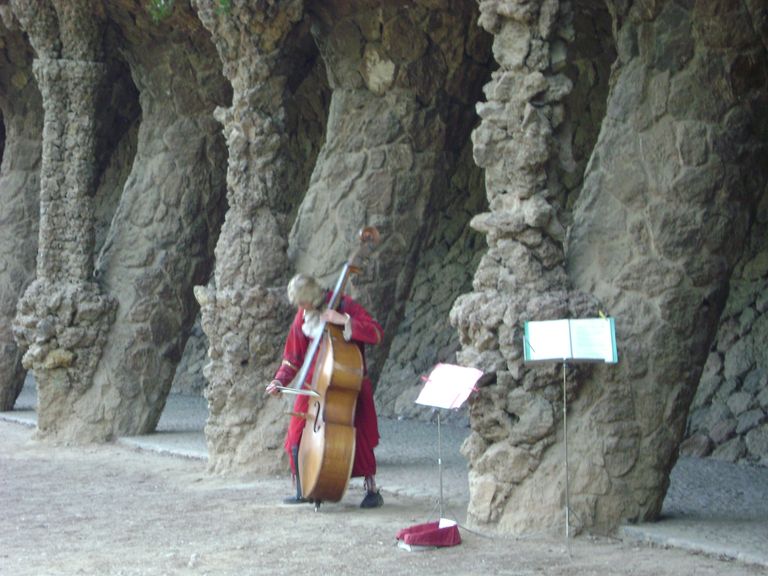
Un aspecto absolutamente llamativo es la tubería instalada en el interior de la sala que recoge el agua de la lluvia que se filtra desde la plaza y luego la almacena en una gran cisterna subterránea.
El dragón de la escalera de cuya boca sale el agua es un detalle donde lo artístico se une a lo práctico, una genialidad más en el arte del gran arquitecto catalán.
Las columnas son estriadas y las más exteriores se inclinan, en un movimiento que a simple vista pareciera ondular en el espacio.
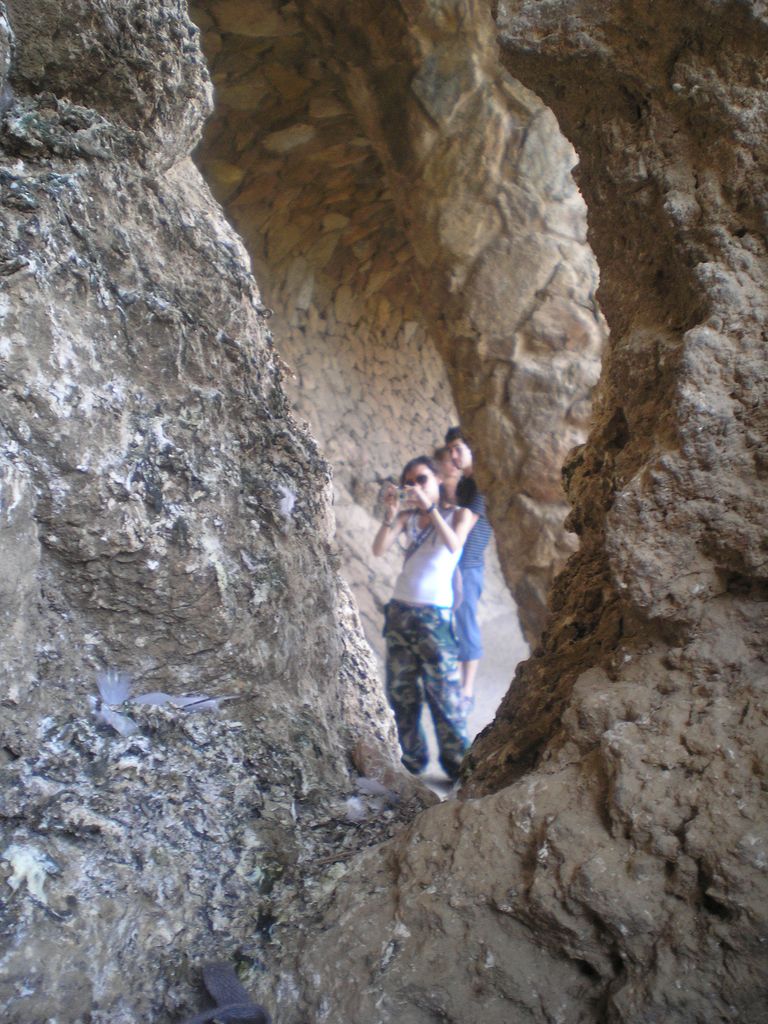
Gaudí's influence is also evident in the ceiling, which is made up of small domes built according to the traditional Catalan technique of partitioned vaults, i.e. thin walls generally made of light, thin bricks, in the Catalan style.
All of them are decorated with the original ceramic mosaic panels in the form of trencadís, so characteristic of all Gaudí's works, designed by Josep M. Jujol, a regular collaborator of the Catalan architect.
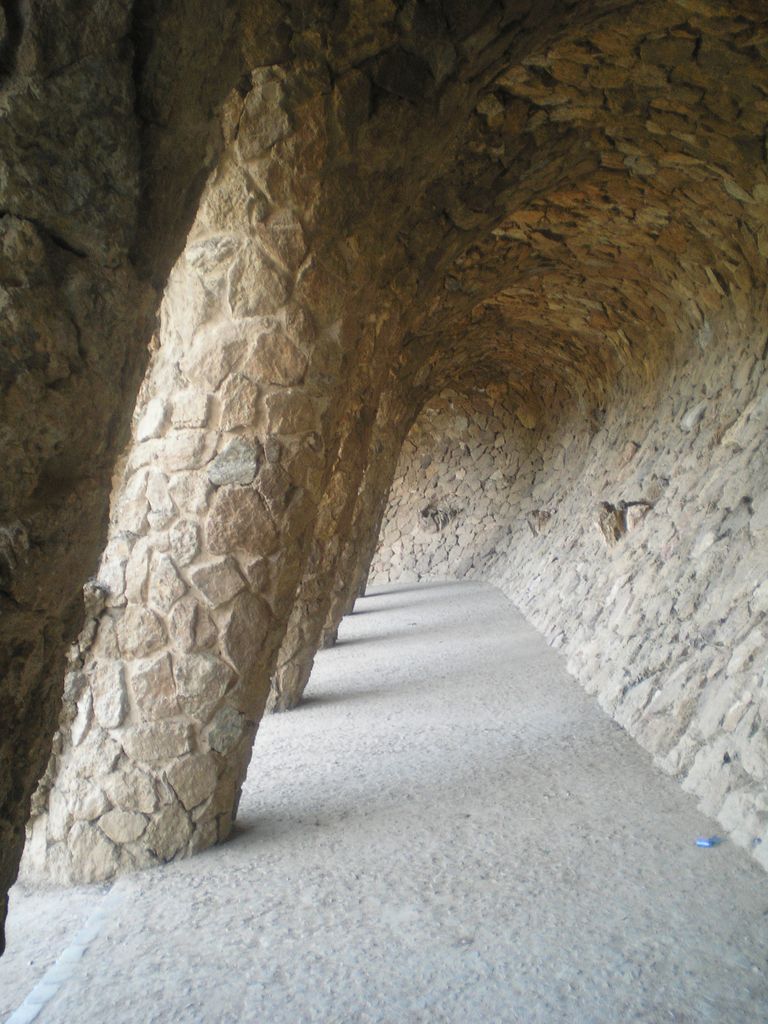
En el techo también se nota la influencia de Gaudí ya que está formado por pequeñas cúpulas construidas según la técnica tradicional catalana de bóvedas tabicadas, es decir paredes delgadas realizadas generalments con ladrillo ligero de poco grosor, al estilo catalán.
Todas ellas ornamentadas con los originales paneles de mosaico cerámico en forma de trencadís tan característicos en todas las obras de Gaudí, diseñados por Josep M. Jujol, un habitual colaborador del arquitecto catalán.
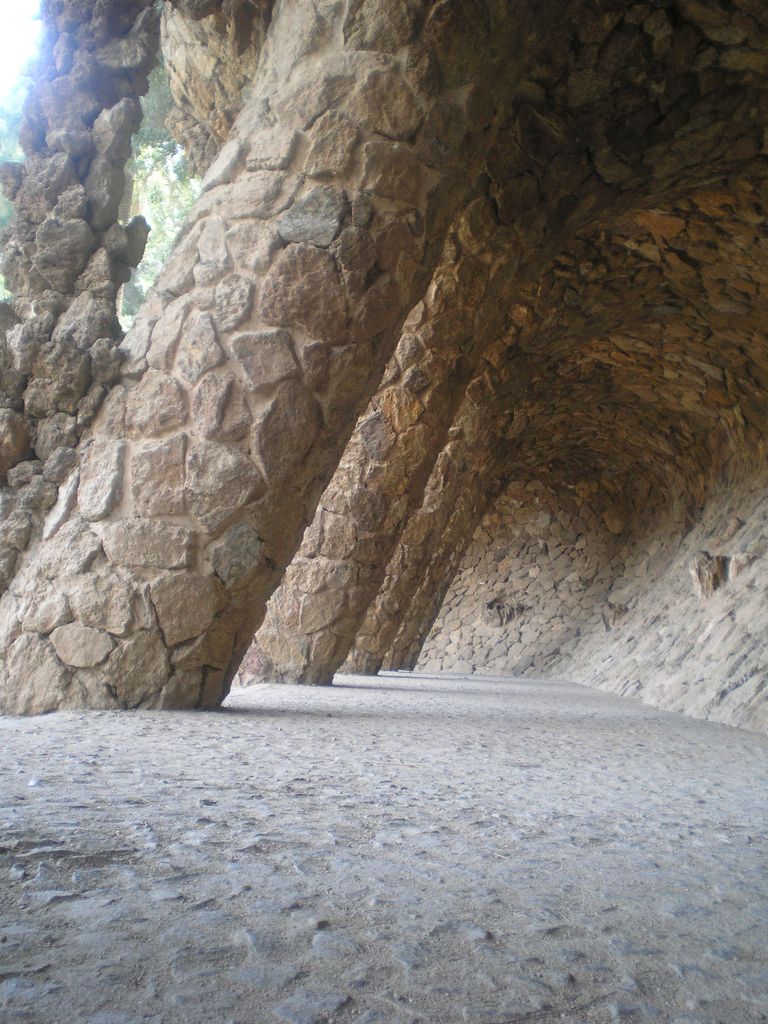
On the ceiling there is also a kind of medallion where Jujol, in addition to the usual fragments of porcelain, experimented artistically with coloured glass paper.
The floor is of smooth, polished rock, but the back wall, on the other hand, is of rough, unworked stone, which creates a notable contrast when the eye is raised from the floor.
The decorative element, somewhere between sacred and profane, so common in Gaudí's works, could not be missing. Indeed, on the outside of the roof one can admire bas-reliefs such as lions' heads spouting water, just like the medieval gargoyles that we are so used to seeing in the literary, artistic and cinematographic works of Victor Hugo, such as the Church of Notre-Dame de Paris.
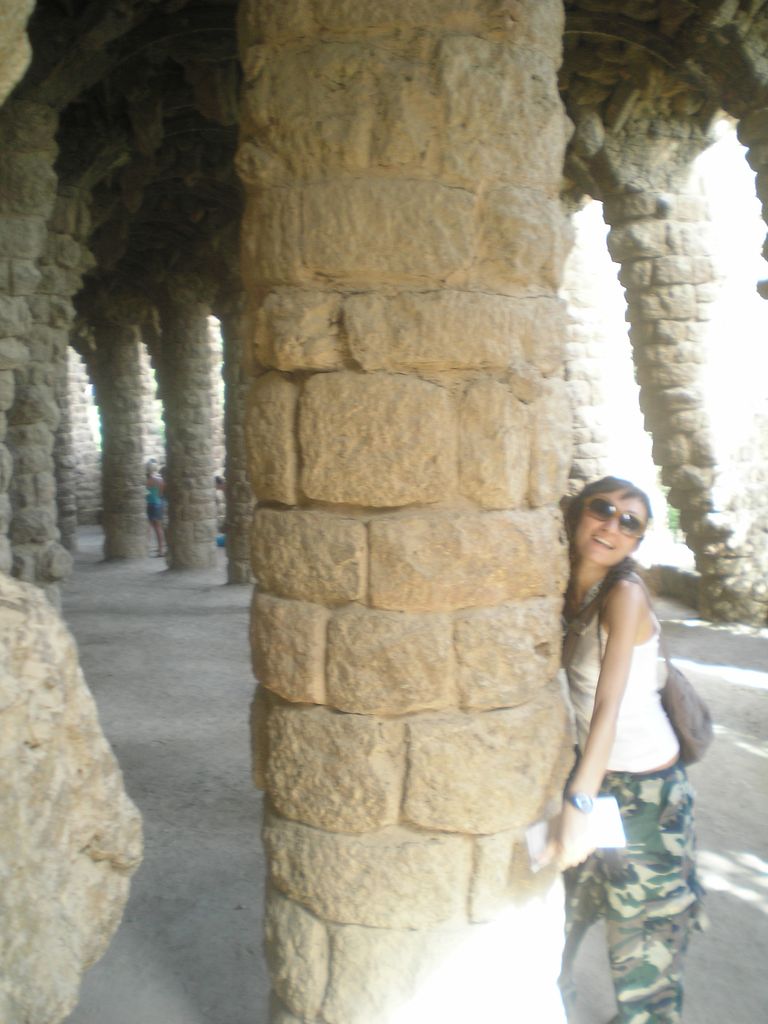
En el techo también hay una especie de medallones donde Jujol además de los habituales fragmentos de porcelana, trealizó experimentos artísticos con papel de vidrio de color.
El suelo es de roca lisa, pulida, pero la pared del fondo, en cambio, es de piedra tosca sin trabajar, lo que ejerce un notable contraste cuando se eleva la vista del suelo.
El elemento decorativo, entre sacro y profano, tan común en las obras de Gaudí no podía faltar. En efecto, en la parte externa del techo se pueden admirar bajorelieves tales como las cabezas de león que sueltan agua, igual que las gárgolas medievales que estamos tan habituados a ver en las obras literarias, artísticas y cinematográficas de Victor Hugo, como la Iglesia Notre-Dame de Paris.

Having failed to fulfil its original purpose, at least what Gaudí intended, this square is now used for festivals and cultural events of various kinds.
For this reason it is usually full of strollers and visitors (foreign tourists and also from other regions of Spain) who enjoy the exceptional views that Park Güell has to offer.
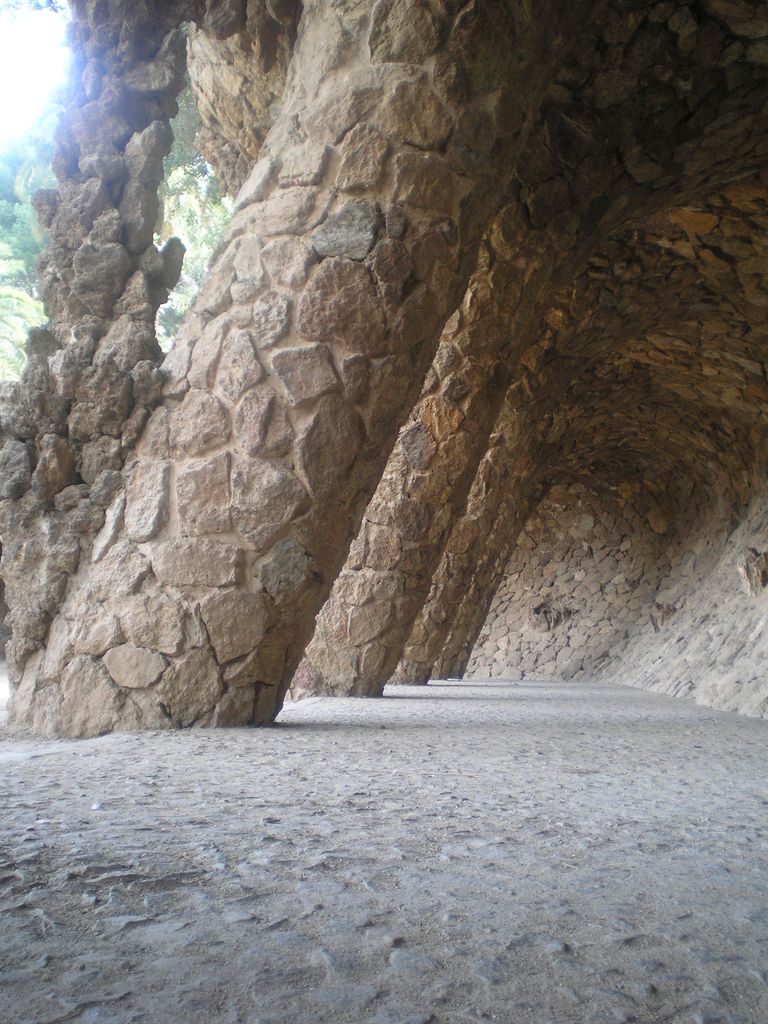
Al no cumplir con su cometido original, al menos lo que se propuso Gaudí, esta plaza se utiliza actualmente para la celebración de fiestas y eventos culturales de diverso tipo.
Por este motivo está normalmente llena de paseantes y visitantes (turistas extranjeros y también de otras regiones de España) que disfrutan de las excepcionales vistas que nos ofrece el Parque Güell.

Trencadis, which translated from Catalan could mean something similar to "minced" or "chopped" to use a gastronomic term, is a type of ornamental decoration characteristic of Catalonia that is formed from ceramic fragments - generally tiles - that are joined together with mortar.
From the impulse and knowledge given through the architectural projects of Antonio Gaudí, this decorative style has become very common and characteristic in Catalan modernist architecture.

El trencadis que traducido del catalán podría significar algo parecido a "picadillo" o "troceado" para usar un término gastronómico es un tipo de decoración ornamental característico de Cataluña que se forma a partir de fragmentos de cerámicos -generalmente azulejos- que se unen con argamasa.
A partir del impulso y del conocimiento dado a través de los proyectos arquitectónicos de Antonio Gaudí, este estilo decorativo ha pasado a ser muy habitual y característico en la arquitectura modernista catalana.
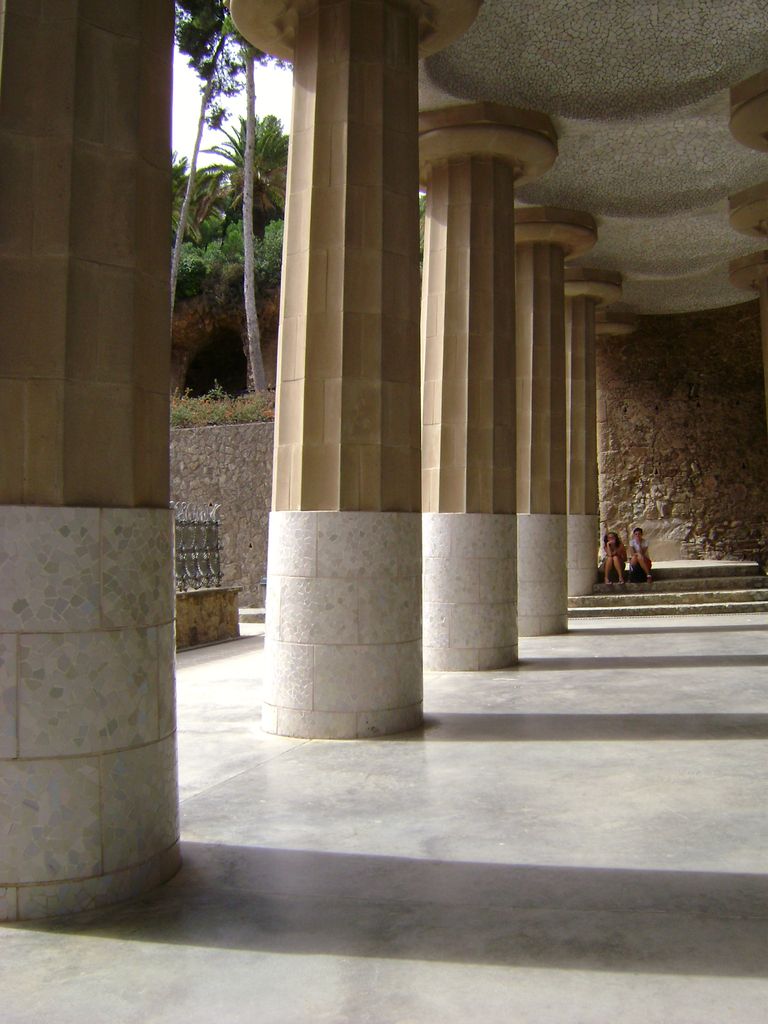
One of Gaudí's works where trencadis has been used the most is undoubtedly in the Sagrada Familia cathedral, perhaps Gaudí's most imposing and spectacular work.
Josep Maria Jujol is considered to have been the one in charge of applying this 'technique' to architectural projects, especially Gaudí's, for the first time and at the same time the one who gave it its characteristic personality.
However, modernist architects had already been applying ceramic tiles habitually on building sites.
Perhaps the difference lies in the composition. Gaudí, together with Jujol, managed to impose a style in which the decorative element was the tiles broken into many pieces and then joined together again in a predetermined style.
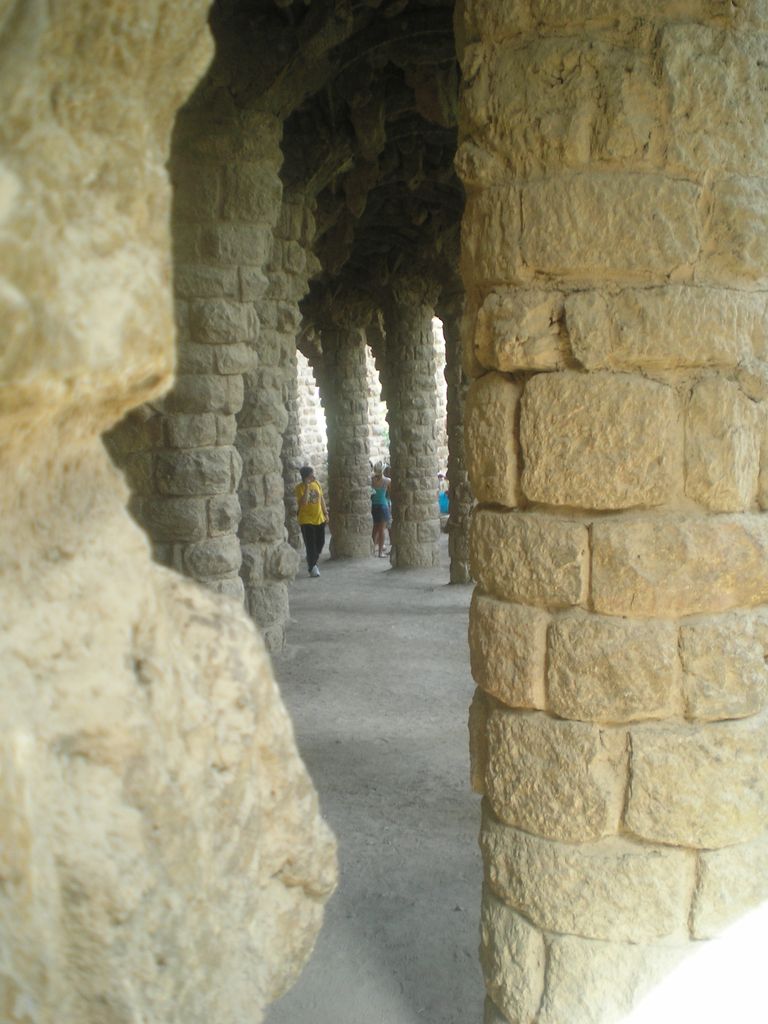
Una de las obras de Gaudí donde más de ha utilizado el trencadis es sin lugar a dudas en la catedral La Sagrada Familia, tal vez la obra más imponente y espectacular de Gaudí.
Se considera que Josep Maria Jujol ha sido el el encargado de aplicar esa 'técnica' a los proyectos arquitectónicos, especialmente de Gaudí, por primera vez y a la vez quien le dio la personalidad característica.
Sin embargo los arquitectos modernistas ya venían aplicando las baldosas cerámicas habitualmente en las obras en construcción.
Tal vez la diferencia esté en la composición. Gaudí logró imponer un estilo junto con Jujol en el cuál el elemento decorativo eran las baldosas rotas en muchos pedazos para volver las a unir después con un estilo predeterminado.
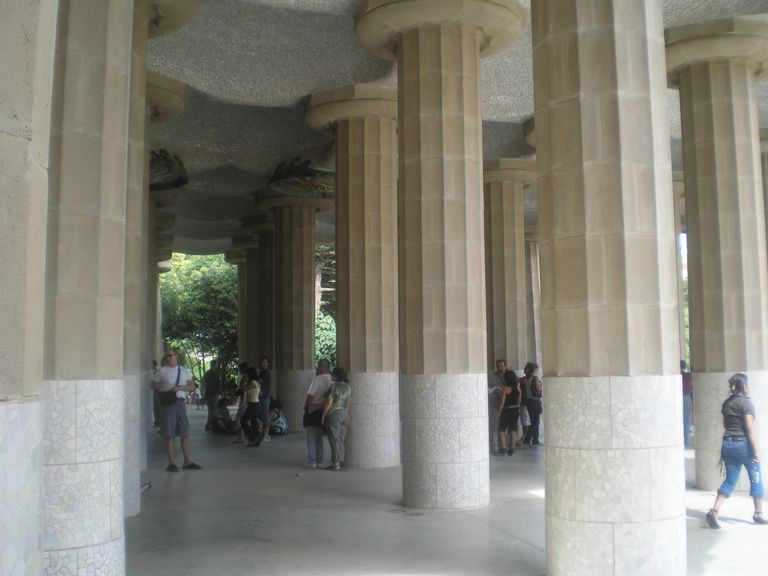
Thanks for reading!!
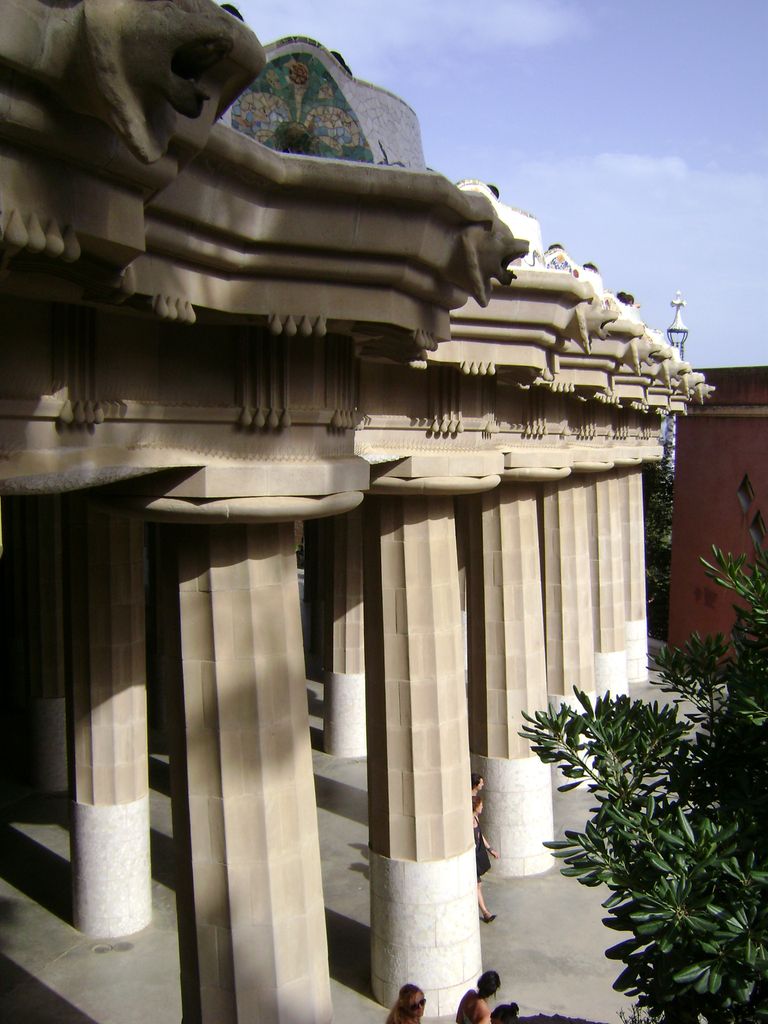
Gracias por leer!!
These images have been obtained in the European summer of 2018 before the ravages caused by the Covid-19 pandemic at the beginning of 2019. They have probably been published in other media that are obviously my property or used in sponsored posts published on my blogs/web at the request of European marketing agencies I work with in Italy, Spain, France, the United Kingdom and other countries.
On the other hand, this text has been cross-posted in my account on another platform, as can be verified in this link.
Estas imágenes han sido obtenidas en el verano europeo de l 2018 antes de los estragos causados por la pandemia del Covid-19 a inicios de 2019. Han sido probablemente publicadas en otros medios que son obviamente de mi propiedad o utilizados en posts patrocinados publicados en mis blogs/web a pedido de agencias de marketing europeas con las que trabajo en Italia, España, Francia, Reino Unido y otros países.
Por otro lado este texto ha sido posteado en forma cruzada en mi cuenta de otra plataforma, como se puede verificar en este enlace.
| Blogs, Sitios Web y Redes Sociales / Blogs, Webs & Social Networks | Plataformas de Contenidos/ Contents Platforms |
|---|---|
| Mi Blog / My Blog | Los Apuntes de Tux |
| Mi Blog / My Blog | El Mundo de Ubuntu |
| Mi Blog / My Blog | Nel Regno di Linux |
| Mi Blog / My Blog | Linuxlandit & The Conqueror Worm |
| Mi Blog / My Blog | Pianeta Ubuntu |
| Mi Blog / My Blog | Re Ubuntu |
| Mi Blog / My Blog | Nel Regno di Ubuntu |
| Red Social Twitter / Twitter Social Network | @hugorep |

Hi @hugo1954, great news! Your content was selected by curators @oneray, @ten-years-before to receive a special curation from BeBlurt 🎉 Don't hesitate to upvote this comment as the curators will receive 80% of the rewards for their involvement.
You can support us by voting for our witness, our decentralized funding proposal, or through delegation. You're also welcome to join our Discord server 👉 https://discord.beblurt.com
Thank you, as always, for the work of curating my content.